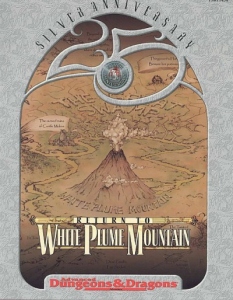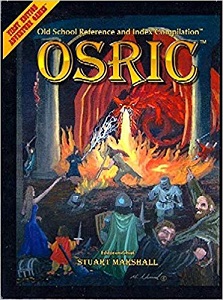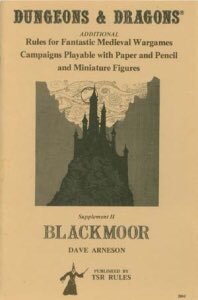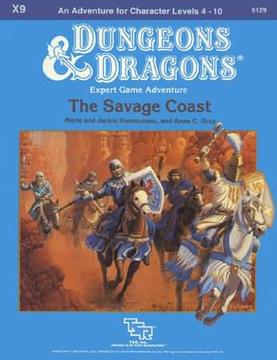Okay, this post will catch me up with all my old school D&D posts that I’ve been doing on twitter! I’ll still be doing them, but will do them less frequently, only after I’ve got a handful from twitter to summarize. So until we meet again, here’s part 10!
S2: White Plume Mountain (1979), by Lawrence Schick. This one is one of the true classics! I think almost every old school D&D player has gone through it!
The second of the S-series after S1: Tomb of Horrors, the adventure tasks PCs to enter the volcano dungeon of the long-thought-dead wizard Keraptis, who has stolen three powerful magic weapons and left a taunting note behind at each theft!
The dungeon is relatively small, but it a “funhouse” of clever tricks and traps. Author Schick basically took the best parts of earlier dungeons he made and pasted them together into White Plume Mountain when he was applying for a job at TSR. He got the job, obviously!
The volcano dungeon is roughly divided into three areas, each of which contains one of the magical weapons. Each area includes a combat with a powerful monster whose lair has been crafted to give it maximum advantage. (I won’t spoil these, though.)
And it really it fun and unique! For example, in one area the PCs can come across a magical stream flowing through the air. There are kayaks available so that they can follow the stream along its course… and into more trouble!
The illustrations in the book, by Erol Otus and David C. Sutherland III, are lovely; I always think of this drawing of a halfling who may be more than he seems…
Speaking of illustrations, Erol Otus’ map of the area surrounding White Plume Mountain is also a classic! None of the areas outside are covered in the module, but the map nevertheless sparked my imagination as a teen.
One interesting quirk of the original adventure is that the PCs never run into Keraptis directly: they hear his disembodied voice, but never find the wizard himself. They must content themselves with reclaiming the lost treasures.
This changes in Return to White Plume Mountain, a sequel that came out in 1999, the twenty year anniversary of the original! It explains more of the history and motivations of Keraptis, such as why he’s stealing weapons to lure adventurers in the first place.
The sequel is pretty trippy, actually. Without going into too much detail, the PCs find that Keraptis has become the magical equivalent of a computer virus, which they must find a way to stop before it overtakes the world. To do so, they will need to reclaim the White Plume Mountain weapons. Speaking of weapons, one of them is a soul-stealing black sword named Blackrazor, an obvious ripoff/homage of the sword Stormbringer in Michael Moorcock’s Elric series of novels…
Schick himself had this to say: “a little embarrassed to this day by Blackrazor, inasmuch as it’s such a blatant rip-off of Elric’s Stormbringer; I would not have put it into the scenario if I ever thought it might be published.” (Remember, he wrote this module for a job interview!)
That hasn’t hurt White Plume Mountain‘s fame, though. It was rated the 9th best adventure of all time in Dungeon Magazine in 2004, and has been reprinted/updated multiple times. It was included in the D&D silver anniversary boxed set with other classics…
… a version for D&D 3.5 was released in 2005, and a 5th edition update of the adventure was included in 2017’s Tales From the Yawning Portal!
Overall, it is a fun dungeon! My favorite thing: if the players are simultaneously very unlucky and very lucky, they might get a taste of the volcanic activity as they get ejected from the cone of the mountain!
PS White Plume Mountain was also reprinted, with the entire S-series, in the 1987 compilation/supermodule Realms of Horror! I want a copy just for the cool cover.
Undead (1986), by Laurel Nicholson. Next up we have another forgotten gem of Mayfair Games’ Role Aids line, featuring one of the grimmest settings of any D&D adventure!
The title of this supplement is kind of misleading, as it does not convey the glorious contents. Undead is a full campaign setting, featuring a land ruled by, and populated by, the dead, called Verdaise!
Verdaise is described as a relatively recent land, formed by a volcanic upheaval that destroyed a dwarven civilization in its place. Now it is a territory which lies in a massive volcanic caldera.
The cataclysm was sparked by an evil god of the dead called Dierguth, who became enraged when the dwarves discovered a magical rock called riegold that can protect living creatures from the energy-draining powers of the undead. Dierguth caused the eruption, and then sent his five Lich Lords into the ruins to build a land of the dead and create a massive army to conquer the living. Their leader is a powerful lich named Nightbay, who has a gross habit of flicking his tongue over his exposed teeth.
The book takes this invasion talk seriously: there are detailed descriptions of the undead army’s organization and combat tactics, such as this undead wedge used to break enemy lines.
But all is not lost: the dwarves that survived the destruction of their home have formed a resistance movement to try and take it back. These freedom fighters live and move through the cooled lava tubes that criss-cross the land of Verdaise.
Undead is a really solid game supplement. It includes all sorts of new material for adventuring in Verdaise, including new magical spells…
… and new magical items.
It also includes new types of undead, as one would hope! My favorite are the creepy Children of Pnogwyn, ghostly murderous children who died in the village of Pnogwyn when their families went to get a cure for the plague that ailed them.
The children were too young to understand that their parents went to get help for them, and believe they were abandoned! So their murderous undead rage is based on a misunderstanding, which I find a fascinating concept.
Undead also contains a complete adventure, “The Brooding Dragon,” in which the PCs are hired by the dwarves to rescue one of their own that has been captured by the undead. Furthermore, this prisoner knows the location of the lost dwarven treasure trove! The adventure is quite fun and dramatic, and includes a really tense encounter in the lava tubes, when a force of the undead make a surprise ambush of the PCs!
Overall, Undead is a well-crafted, atmospheric and fun supplement. It was perhaps the earliest one to feature a “Land of the Dead” for players to explore, and has lots of nice touches that make it stand out!
Elven Banner (1985), by Laurel Nicholson. Let’s look at another Role Aids product, and another one by the author of the delightful Undead!
This adventure is a fascinating early adventure for D&D that uses time travel as a major plot device! In the present, an evil invasion force threatens Castle Alzarhed, and Alzarhed’s forces only have a chance if their forces use a powerful magic banner.
The problem? The banner was destroyed 50 years earlier when a mysterious tragedy ruined the original castle and killed everyone inside, including the king at the time. So the PCs must go back to a time before it was lost, in order to bring it to the present to stop a tragedy. So the PCs must go back to a time to get a powerful item before it was destroyed, in order to bring it to the present to stop a tragedyWAITAMINIT
Kidding aside, it is a pretty cool adventure. The PCs go back to the day before the destruction of the castle, when a festival is taking place there. A number of different plots and schemes are taking place, unbeknownst to the players, and they can get in REALLY over their heads.
Fortunately, time travel works in their favor in this case. In rather unique mechanics, the PCs are much harder to kill — since they aren’t actually FROM the past, they can take a lot more damage that won’t catch up until they return to the present.
The PCs start by attending the festival, and their most likely plan is to take secret paths, described by a servant in the present, to go into the dungeons below in search of the banner and, eventually, into the castle above.
Note the isometric maps — this was a relatively new development in D&D at the time, most notably in the first Dragonlance module, Dragons of Despair, that came out in 1984.
As I noted, the events that unfold that leads to the castle’s destruction are quite complicated. The PCs can inadvertently meddle in them, making things FAR WORSE in the present or even cause the tragedy to never occur in the first place… though if they prevent the tragedy from happening completely, they’ll return to the present to find nobody knows of their adventure and they won’t get paid!
There are a number of nice atmospheric touches, as well. The PCs can play a carnival game at the castle festival, which can provide them magical items that help them greatly — or completely screw them over.
The adventure even suggests using characters with long history in the region, so older PCs might run into their younger selves during the trip!
Overall, Elven Banner is another really clever adventure in the Role Aids line of products. It’s one that is clever enough that I’m tempted to adapt it to run using 5e!
PS with Elven Banner, it turns out that there are more time travel classic D&D adventures than I realized! We also have the Blackmoor adventures, and Chronomancer…
… but beating them all is Ghost Tower of Inverness (1980), in which the PCs travel through the dungeon of a ruined tower, eventually using a magic portal to go back in time to when the tower was still standing!
AA 2, The Red Mausoleum (c. 2006), by James Boney. Next up, let’s look at another of the relatively recent old school revival products, seeking to capture that classic TSR AD&D feel!
I say “circa 2006,” because the product doesn’t even have a date printed on it! But Expeditious Retreat Press has been going since 2003, and AA 2 is the second module, so it must have appeared early in the company’s history. Furthermore, the module is designed for OSRIC. What’s OSRIC? Old School Reference and Index Compilation, a rough clone of first edition Dungeons & Dragons that was first released in 2006, and is free to use and download.
OSRIC is a great standardized platform for those who want to get that genuine old school feel. And there’s clearly a market: when WotC released premium reprints of 1st edition AD&D in 2012, they got a huge response! And that printing is often pricier than originals!
So how is The Red Mausoleum? From the cover, you can see that the author really wanted to capture that first edition AD&D feeling, even down to the font and layout of the module. There’s even a rumor table, a common staple in many 1e adventures.
As the introduction suggests, something sinister is causing the undead to rise, and the PCs must visit the Red Mausoleum, a 3-level dungeon filled with traps and monsters, to find the source of the outbreak and stop it!
It is a clever enough adventure, definitely one for the nostalgia buffs! I definitely feel a surge of memories looking at the classic style artwork and adventure layouts.
I’ll be checking out more of the “Advanced Adventures” line as I go, as I’m curious to see how the adventures developed as the company gained more experience and matured.
Village Book 1 (1978), by Judges Guild. Some of the most beautiful old school products are not adventures at all, but supplements that are designed to make the creation of adventures easier. Judges Guild were the masters of this back in the day, as is evidenced by their Village Book 1.
As a reminder: Judges Guild was founded in 1976 to produce high-quality gaming supplement for Dungeons & Dragons, and were even officially licensed to do so for quite a while. The Village Book is one of their early products, but it is a beauty. What is it? It is a resource for quickly creating all the details of a village, practically on the fly, when needed for a D&D campaign. This includes figuring out the system of government, the shops present in the village, and even the name of the village.
The type of shops one might find in a village are based on the system of government. All of this, of course, is determined by random dice rolls.
And the naming is great! Village names are determined by two sets of rolls: one for the prefix, one for the suffix. The images below just give you a taste of the massive variety available.
But the real stars of the book are the gorgeous village maps! There are over 30 of them, with different layouts and topography, all centered on hex grids for easy inclusion in a greater campaign map. Here are four, as examples.
This is a really lovely, useful product that I will probably use in my own future campaigns! Fortunately, it is available on DriveThruRPG in pdf form, along with the Castle Books, Temple Book, and Island Book.
So… Village Book I is a beautiful, classic product. So glad I bought an original copy! One gets lovely back cover surprises, too.
Dave Arneson’s First Fantasy Campaign (1977). This one is a real treat, though it may take some explanation to see why!
So, first things first: who was Dave Arneson (1947-2009)? Arneson was the co-creator of Dungeons & Dragons, along with Gary Gygax, and really the first person to introduce true fantasy roleplaying. Arneson had introduced fantasy dungeon adventures in 1970 into his wargaming group, and drew upon fantasy elements from Gygax’s “Chainmail” combat rules. Arneson met Gygax in 1972 and showed off his campaign setting, which led to the founding of D&D and TSR.
So, to clarify: Gygax had introduced fantasy elements into wargaming, but Arneson was the one who really first made a game out of fantasy storytelling. The fantasy world he built was Blackmoor, which ended up being one of the earliest D&D supplements, too!
So, that Blackmoor supplement, despite the name, didn’t actually have much in the way of actual details about the world of Blackmoor, other than the first published RPG adventure: The Temple of the Frog, which later was made into a modern TSR release.
In 1976, Arneson and Gygax had a major falling out. Arneson left the company, and in 1977 TSR actually claimed it owed him no royalties! He ended up suing them, multiple times. Meanwhile, also in 1977, Arneson wrote up Blackmoor as a Judges Guild supplement: “First Fantasy.”
First Fantasy is really an odd publication: it is really more of a historical document than a genuine gaming supplement, as it contains miscellaneous notes, tricks, and background that Arneson used in building the fictional world of Blackmoor. But it is packed with ideas! Here’s the table of contents.
The first sections of First Fantasy are really rules for extended wargaming campaigns between factions of Blackmoor. Not surprising, as fantasy RPGs, and Blackmoor itself, evolved from Arneson’s (and Gygax’s) original wargaming hobby.
We’re also treated to a rough early map of some of the northern reaches of the campaign world.
Arneson’s campaign is fascinating because (a) it didn’t take itself too seriously and (b) lots of RPG tropes hadn’t evolved yet. A main Blackmoor villain, “The Egg of Coot,” is a weird multi-formed being that, yes, sometimes looks like an egg.
The details become more interesting the further one goes into the book. Important buildings in the town of Blackmoor are introduced, including the “Comeback Inn,” which is the main adventure location for the later module DA1: Adventures in Blackmoor.
Castle Blackmoor is also described in some detail. It is now a haunted ruin, and the ghosts of every location are described.
And, of course, the town of Blackmoor is mapped out. It seems quite small compared to the description in the much later DA1. Apparently Arneson evolved it into a major city by that time.
One of the highlights of the book, however, is a description of the original Castle Blackmoor dungeons, literally the first dungeon RPG adventure ever created! As you can see, the descriptions for the rooms were very, very, simple.
A really neat touch in the many, many levels given (I think there are nine?): the dungeons connect on multiple levels with the sewers of the town.
My favorite thing about the book, though, are plot-generating innovations that would not really be reinvented for years in RPGs. Arneson introduced random “fortune-telling” into his campaign, basically making things as unpredictable for him as for the players.
Note that he mentions “Chance Cards,” in capital letters. He doesn’t spell it out, but I’m wondering if he meant actual Chance Card from Monopoly? This would be a BRILLIANT way to generate new random craziness.
Bear with me, here: “Go directly to jail?” The PCs are falsely accused of a crime and sent to prison, where they must make a daring escape in order to prove their innocence.
“You have been elected chairman of the board?” One of the PCs is forced to become a public servant, and gets drawn into both mundane tasks as well as political corruption and intrigue.
If we expand to “Community Chest,” then “Bank error in your favor” could represent the PCs accidentally coming into possession of a powerful magical artifact that is being sought by multiple sinister groups.
As I said, it’s unclear if actual Monopoly cards are what Arneson was thinking about. He includes a d100 table of events to represent random events, as well.
But the notion of using cards to drive the story in unexpected directions would return many years later, in my favorite RPG, Torg! In Torg, players can play subplot cards to add some spice to the adventure. Now that I think about it, one could use Tarot cards as another random adventure generator.
Finally, I should mention the beautiful maps! First Fantasy comes, as many Judges Guild products did, with two maps: one annotated one for the DM, and another empty one for the players.
Incidentally, you might ask how Arneson managed to design a detailed fantasy campaign setting in that early era? He apparently used an old map of Holland, rotated, as an inspiration. Not easy to see, but one can imagine Blackmoor as sitting where Amsterdam is.
Arneson and Gygax did eventually reconcile, and this allowed Arneson to return to TSR in the mid-80s to pen three adventures set in Blackmoor, which we have discussed before! And the setting has lived on! In 2004, an edition of the late Arneson’s setting was published by Goodman Games. It makes me happy that Arneson’s original ideas remain of interest and continue to return to print.
The Illhiedrin Book (1981), by Daniel Hauffe. I am somewhat obsessed by Judges Guild these days, even picking up some of their more obscure adventures, such as the following.
Judges Guild, as we’ve discussed, was an early company with permission to make official D&D products. Some of these are amazing classics, like Dark Tower. Illhiedrin is *not* a classic, but it does hold some ideas that were clever for their time!
The PCs are hired by the sorceress Alcastra to track down the lost Illhiedrin Book, a book of great power that was held by a famous wizard but was lost when the wizard mysteriously disappeared.
One can see how early published adventures hadn’t yet gotten the “feel” for what needs to be included in the book; The Illhiedrin Book actually contains detailed descriptions of Alcastra’s tower, though the PCs will spend relatively little time there, and it isn’t a combat area!
The module does, surprisingly, contain a number of color images, which was pretty remarkably rare for that era. Here is one of the servants of Alcastra, again not really needed but quite nice.
Oh, and the lady on the cover? That’s Alcastra. How do I know? Because she’s also pictured inside the book, by name.
The adventure itself partly plays out as an investigation. The PCs must travel to a village for clues to the whereabouts of the wizard. From interviews, they are led to the wizard’s tomb, which is a more standard dungeon adventure. At the end of the tomb, they meet the ghost of the wizard, who tells them how to find his (invisible) tower, and warns them that he was chased out by a powerful creature that he and his servants could not defeat!
This creature is one of the nice twists of the adventure. The Creature survived the wizard’s attacks because it feeds on, and is healed by, any magical attacks, spell or magical weapon. Such attacks increase its hit points and make it grow younger.
If the PCs figure this out early, they will have an easy battle, as the creature is weakened after years without magic in the tower. If they don’t figure it out, they could be facing a nearly unstoppable foe! These days, however, I think players would figure out the puzzle pretty quickly. They might even deduce it BEFORE meeting the creature, if they meta-wonder how their first-level characters will be able to defeat a creature that a high-level wizard couldn’t!
After getting the book, the PCs run into the other clever twist: throughout the mission, they’ve been stalked by two opposing parties also interested in acquiring it! Outside the tower, this leads to a showdown between the three groups — or even more groups, because the adventure details how other factions, or folks with a grudge, could show up right then to make it a 5- or 6-fold standoff!
Overall The Illhiedrin Book is more or less a decent quality but not super memorable adventure. I originally bought it to see what “non-famous” Judges Guild products were like, and I also liked the color scheme on the cover!
PS the final multi-party battle suddenly reminded me of the big news fights in the Anchorman movies!
Red Steel (1995), by various authors. Okay, this is a product that I didn’t even know existed until I stumbled across mention of it earlier this year!
This one is wild. It was apparently part of a push, in the mid-90s, to take the classic D&D setting of Mystara, which first appeared in the Isle of Dread, and convert it into an AD&D setting. Why? Not sure — perhaps TSR was trying to simplify to one set of core rules. By the mid-90s, the company was seriously struggling, in part due to the huge variety of settings available.
The earlier conversions in the series were Karameikos: Kingdom of Adventure (1994) and Glantri: Kingdom of Magic (1995). Red Steel appears to have been the unofficial third in a never-completed line that would flesh out the whole setting for AD&D.
Red Steel is set along the “Savage Coast” of Mystara: basically a largely undeveloped land far west of the known world that has now been colonized. This map from the book shows how far it is from Karameikos.
The Savage Coast first appeared in D&D back in 1985, where it was the locale of a module of the same name, X9: The Savage Coast. It is significantly changed in Red Steel, however…
In Red Steel, much of the wilderness has been covered with a magical red dust, called vermeil. This dust, when ingested, can give people magical powers, called Legacies. Basically, this means that everyone on the Savage Coast has at least one superpower!
The catch is that a vermeil-induced Legacy also causes mutations and drains ability scores. This can be warded off by wearing an amulet of a native rock called cinnabryl. However, cinnabryl loses its power rapidly, which means the PCs must change it out regularly. On the bright side, depleted cinnabryl can be forged into powerful weapons made out of — dun dun DUNNNN — Red Steel!
The setting of Red Steel is clearly intended to have very much a colonial Africa vibe, with native groups fighting with colonists for territory and survival. It is also intended to be quite freewheeling and strange — players can play many strange races! Among those races: rakasta (cat-like humanoids), lupins (dog-like humanoids), tortles (turtle-like humanoids). Not pictured (I think): aranea, spider-like beings that can assume spider form or human form. There are also scorpion men, like in the epic of Gilgamesh!
The Red Steel boxed set contains a number of items. Of course, it includes a setting book that describes the region and its politics, as well as a campaign book that describes the new rules…
… and it also includes several full-color maps, of which this is but one part.
In a very 90s way, it also includes: a CD, which contains music the DM can use to set the mood and atmosphere for gameplay!I get the feeling traditional D&D was feeling the pressure from videogames at this point, and was trying to go more multimedia to compete.
I tried out the CD a couple of weeks ago as background music for my own RPG game, and it’s not bad! I’m tempted to upload at least one track later for folks to hear, since it doesn’t seem to be available otherwise.
Overall, Red Steel is a weird and fun attempt to spice up a campaign. It shows how much TSR was willing to experiment in those last few years to keep the attention of their audience.
*********************
Whew! All caught up on my earlier twitter posts! I can’t believe how many old school D&D threads I’ve done! More to come in the future…

























































































Reblogged this on DDOCentral.